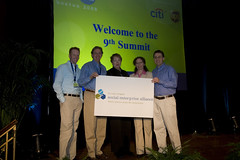Highlights from the 9th annual Social Enterprise Summit
March 20, 2008
9th Annual Social Enterprise Summit
I had the pleasure of attending the Social Enterprise Summit in Boston last week at the regal Park Plaza Hotel.
The two days were packed with activities that were divided into two tracks: educational sessions led by leaders and practitioners in the field, or structured networking activities that were dialogue-based.
The agenda took a soup-to-nuts approach, covering everything from start-up to scale-up, from strategic partnerships to influencing public policy.
Under the networking umbrella, “Speed Dating,” attorneys provided free consultation for owners and managers facing legal issues or problems. A “Marketplace Mixer” presented information on earned income models. There were opportunities for identifying potential suppliers and distributors, sharing trade secrets and even making sales. Social Enterprise Tours provided guided visits around Boston to clusters of social enterprise activity.
It felt like a day at camp: frenetic at times, where a bathroom stop threatens to throw off your schedule. Unlike camp, however, it was entirely up to you how much you wanted to pack in. There were ten seminars per session from which to choose and three sessions per day. With so many worthy choices, selection was a challenge.
Some of the more interesting titles included:
- Merging Money & Mindset: Social Enterprise at its Best!
- Win, Win, Win: A Community Capacity Building Model that Works
- But is it Legal? The Do’s and Don’ts of Nonprofit Ventures
- Unlikely Bedfellows: Innovative Partnerships that Yield the Best Results
I decided to go with my tried-tested-and-true diversification strategy that successfully guided my undergraduate program at McGill. I audited a session called “The L3C: The For-Profit with the Non-Profit Soul,” a new corporate model for social enterprise that now has legal entity status in certain states. The panelists included heavy hitters: Robert M. Lang Jr., CEO of the Mary Elizabeth and Gordon B. Mannweiler Foundation Inc., and Arthur Wood, Director of Financial Services for Ashoka.
I should have remembered from previous experience (they led a panel at MaRS’ Social Finance Forum back in Oct ’07) that I would be left with a bad case of writer’s wrist. It was 90 minutes of sense-making between Bob Lang’s acronyms for the American legal system and organizational structures, and Arthur’s reality checks. He burst the collective bubble about venture philanthropists by pointing out that the massive amount held by the Gates Foundation is only, after all, roughly what the Pentagon spends every two months.
I landed in a session on matchmaking funders with promising social enterprises, which left me with a great model and the need to do some further digging on the impressive, lead presenting organization, REDF (formerly the Roberts Enterprise Development Fund).
Day two started with a session on form vs. function entitled: “Social Values and Organizational Design.” It was led by Allen Bromberger from Perlman and Perlman, a firm that specializes in working with the philanthropic community, and Jim Fruchterman, the CEO and self-proclaimed business entrepreneur-cum-social entrepreneur of Benetech in San Francisco.
The pairing was a great dynamic: the trusted advisor and lessons from the trenches. The overall message: Don’t choose form before function. Don’t assume what kind of organization you are going to start (i.e., for-profit, non-profit, hybrid) before thorough due diligence on which form best delivers upon mission and outcomes.
All in all, I was very impressed by the turnout and proceedings. For perhaps the first time, legal pundits, funders of all sorts, practitioners of social enterprise and non-profits seemed to be sharing a common language. It was encouraging and exciting to see how many people are considering this space — social enterprise — their milieu.
